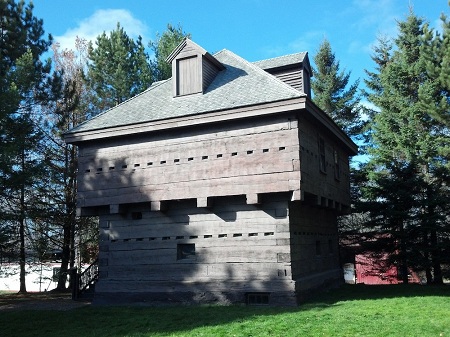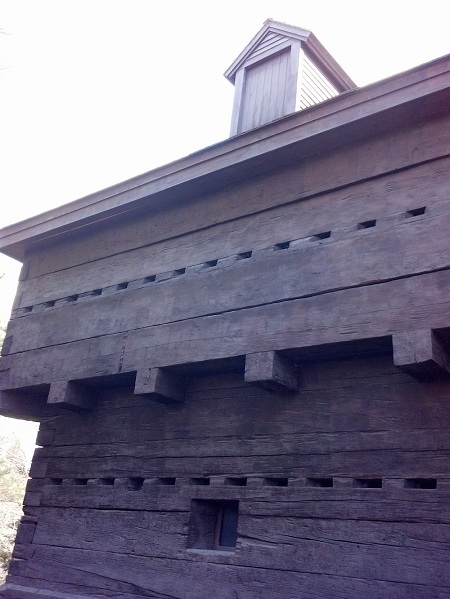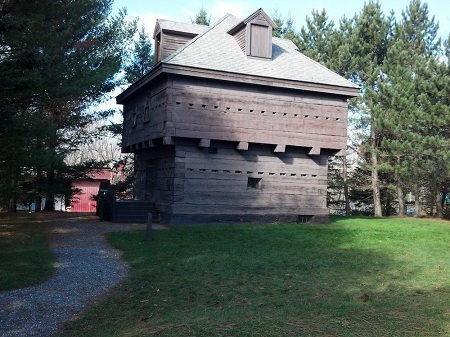Often called the "Pork & Beans War," the Aroostook War was a confrontation between the United States and Great Britain. The war, which look place in 1838 and 1839, was over the international boundary that separated Canada, which was a British holding, and the state of Maine, which was an American state in the United States. Although there were numerous skirmishes, there were no military personnel killed in the dispute. The only two casualties were two American soldiers who drowned near Ft. Kent.
Feature Article
Aroostook War

There has only been one time in American history
when a state
declared war unilaterally on another country, and this is the story of
that one time.
 The whole thing started with the Treaty of Paris,
the peace treaty of 1783 which ended the American
Revolution. That treaty was unclear when it divvied up the land
between Britain's Canadian colony of New
Brunswick, and America when it described the "highlands" which would
be the boundary between the two countries.
The whole thing started with the Treaty of Paris,
the peace treaty of 1783 which ended the American
Revolution. That treaty was unclear when it divvied up the land
between Britain's Canadian colony of New
Brunswick, and America when it described the "highlands" which would
be the boundary between the two countries.
Amid the confusion, the Commonwealth of Massachusetts
issued land grants in the District of Maine which included some of the
disputed territory.
And during the War
of 1812, for more than eight months, British troops occupied most of
the eastern portion of Maine, including Hancock County, Washington County,
and parts of Penobscot County, intending to annex those occupied areas to
Canada.
In 1820 Maine seceded from Massachusetts, becoming a state in its own
right, and the issue of northern boundaries became even more of an issue.
The British, who believed that Maine had encroached into their territory,
could cut travel time between Halifax
and Quebec
City in half if they could get control of the disputed territory.
In 1830, negotiators from the Britain and the United
States, still unable to agree on the national boundary, and they
finally referred it to the King of the Netherlands,
William I, who announced in 1831 that "the Treaty of 1783 was so badly
worded that it could not be translated into a practical topographical
boundary." He finally gave up, calling the treaty impractical and devised
a compromise which England
accepted but Maine rejected, and so the Senate rejected the treaty after
the strong and outraged insistence of the people of Maine.
In the meantime, lumbermen and trappers from Canada
and settlers from New England had begun moving into the disputed region
called Aroostook, and they locked horns repeatedly, with officials and
run-of-the-mill groups of men from both sides of the disputed border
taking prisoners and asserting the arrests of those they considered
trespassers.
So in 1837 when a Maine census representative was arrested by New
Brunswick officials while he was conducting a census in the St. John
Valley, Maine's Governor Robert Dunlap issued an order, announcing that a
"foreign power has invaded Maine."
His demands that the federal government take action were ignored by
Washington, which was preoccupied with the Cherokee removal and other
Indian uprisings, so the Maine state legislature authorized $800,000 for
military defense.
 Spurred on by the irate Mainers, Congress gave President Martin Van Buren
the authority to raise the militia with a $10 million budget and raised a
militia of 50,000 men to defend Maine's land claims.
Spurred on by the irate Mainers, Congress gave President Martin Van Buren
the authority to raise the militia with a $10 million budget and raised a
militia of 50,000 men to defend Maine's land claims.
The Maine legislature set aside of $10,000 for defense of the disputed
region and the building of a military road. That road followed what is now
U.S. Route 2 to Macwahoc, then what is now Route 2A to Houlton.
This military road was specifically for troop movement from Bangor
to Houlton. At the same time, Fort Knox, in Prospect, was built in order
to defend mid-Maine in the conflict which was heating up. Fort
Kent was also established where the Fish River and the St. John
River meet in the St. John Valley. Fort Kent was named in honor of Maine's
then-Governor, Edward Kent, who was instrumental in both the instigation
and the resolution of the Aroostook War. The site of that military
installation in the northern tip of Maine's Aroostook County was
situated is now the town of Fort Kent, and the only evidence of that war
in that town is the blockhouse (pictured here), which remains standing on the waterfront
to this day.
While it was not a "war" in the conventional sense, local militia units
were frequently called out, even if no actual combat
ensued.
In January of 1839, the state legislature authorized Governor John
Fairfield to send the State Land Agent and future United
States Congressman Rufus McIntire and an expedition of 200 Mainers
to pursue trespassers from New Brunswick. They arrested several Canadians,
including the New Brunswick warden, and confiscated the arrestees'
equipment.
A cadre of New Brunswick lumbermen retaliated by arresting several of the
Mainers, including McIntire, whom they transported to Woodstock in chains.
In 1842, Daniel Webster, who was the Secretary of State at the time, and
Baron Ashburton, a British diplomat, negotiated a settlement of the
conflict, which is called the Webster-Ashburton Treaty. That treaty
established a border between Canada and Maine, with Maine getting the bulk
of the disputed area and at the same time decreeing a commercial
right-of-way for English ships to travel through Maine en route to Nova
Scotia and New Brunswick.
The settlement settled boundary issues between Canada and Maine,
Michigan,
Minnesota,
and New
Hampshire by carving out land from within New England's two states
and giving land including the Upper Peninsula of Michigan to that state.
The government of the U.S. agreed to pay Maine and Massachusetts each
$150,000 to compensate them for their land losses.
In all, and aside from bruised egos and loss of a few days of freedom for
various Mainers and New Brunswickers, 38 men died, though not a single
death was combat-related.
The only other casualties were incurred in Houlton, where troops from
Britain and from Maine were drinking when someone loudly toasted to
Maine's success. A bar brawl erupted, and there were numerous bloody noses
and black eyes.
Recommended Resources
A Young Soldier's Account of the Aroostook War
Letters from a young militia soldier who was involved in the Aroostook War describe what it was actually like to be there.
http://www.mpbn.net/homestom/p13soldierswar.html
Presents information about this unilateral war as well as the lyrics to "The Aroostook War Fighting Song."
http://members.tripod.com/scott_michaud/Aroostook-War.html
Maine Army National Guard: The Aroostook War
The story of the bloodless Aroostook War and the personalities behind the scenes.
http://www.me.ngb.army.mil/about/history/aroostook-war.php
A brief account of the war, the early years, and the origins of the name of the Aroostook County.
http://kenanderson.net/aroostook/war.html
Gives details about how the border between Maine and New Brunswick was fixed. Offers the full background, politics, and treaties.
http://www.upperstjohn.com/history/northeastborder.htm


